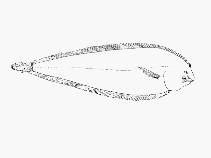Austroglossus microlepis (Bleeker, 1863)
West coast sole
Ajouter votre observation dans Fish Watcher
| Native range | All suitable habitat | Point map | Year 2050 |

|
| This map was computer-generated and has not yet been reviewed. |
| Austroglossus microlepis AquaMaps Data sources: GBIF OBIS |
Envoyez vos Photos et vidéos
Pictures | Images GoogleAustroglossus microlepis
Picture by SFSA
Pictures | Images GoogleAustroglossus microlepis
Picture by SFSA
Common names from other countries
Classification / Names Noms communs | Synonymes | Catalog of Fishes(Genre, Espèce) | ITIS | CoL | WoRMS | Cloffa
> Pleuronectiformes (Flatfishes) > Soleidae (Soles)
Etymology: Austroglossus: Composed from Austro = the south + Greek, glossa = tongue (Ref. 45335).
More on author: Bleeker.
Etymology: Austroglossus: Composed from Austro = the south + Greek, glossa = tongue (Ref. 45335).
More on author: Bleeker.
Environment: milieu / climate zone / depth range / distribution range Écologie
marin bathydémersal; profondeur 100 - 400 m (Ref. 5304). Deep-water; 17°S - 35°S, 10°E - 25°E
Distribution Pays | Zones FAO | Écosystèmes | Occurrences | Point map | Introductions | Faunafri
Southeast Atlantic: northern Namibia to False Bay, South Africa.
Taille / Poids / Âge
Maturity: Lm ? range ? - ? cm
Max length : 75.0 cm TL mâle / non sexé; (Ref. 3200); poids max. publié: 4.0 kg (Ref. 3200)
Max length : 75.0 cm TL mâle / non sexé; (Ref. 3200); poids max. publié: 4.0 kg (Ref. 3200)
Description synthétique Clés d'identification | Morphologie | Morphométrie
Épines dorsales (Total) : 0; Rayons mous dorsaux (Total) : 82 - 100; Épines anales: 0; Rayons mous anaux: 65 - 78; Vertèbres: 55 - 57. Dorsal and anal fins continuous with caudal fin (Ref. 36731). Right pectoral fin more than half of, but shorter than head length; left pectoral fin present (Ref. 36731). Brownish with small dark specks; sometimes with bars on body (Ref. 3200).
Larvae are pelagic (Ref. 27121, Ref. 36731), while adults live close to the sea bed (Ref. 36731). Adults feed on worms, crustaceans, mollusks, and fish (Ref. 27121, Ref. 36731). Utilized as a food fish (Ref. 4931).
Life cycle and mating behavior Maturité | Reproduction | Frai | Œufs | Fécondité | Larves
Référence principale
Upload your references | Références | Coordinateur | Collaborateurs
Heemstra, P.C. and O. Gon, 1986. Soleidae. p. 868-874. In M.M. Smith and P.C. Heemstra (eds.) Smiths' sea fishes. Springer-Verlag, Berlin. (Ref. 3200)
Statut dans la liste rouge de l'IUCN (Ref. 130435: Version 2024-2)
Données manquantes (DD) ; Date assessed: 25 June 2021
Menace pour l'homme
Harmless
Utilisations par l'homme
Pêcheries: intérêt commercial mineur
FAO(pêcheries: production; publication : search) | FishSource | Sea Around Us
Plus d'informations
Trophic ecology
Éléments du régime alimentaire
Composition du régime alimentaire
Consommation alimentaire
Food rations
Prédateurs
Éléments du régime alimentaire
Composition du régime alimentaire
Consommation alimentaire
Food rations
Prédateurs
Population dynamics
Paramètres de croissance
Max. ages / sizes
Length-weight rel.
Length-length rel.
Fréquences de longueurs
Mass conversion
Recrutement
Abondance
Paramètres de croissance
Max. ages / sizes
Length-weight rel.
Length-length rel.
Fréquences de longueurs
Mass conversion
Recrutement
Abondance
Life cycle
Reproduction
Maturité
Fécondité
Frai
Spawning aggregations
Œufs
Développement de l'œuf
Larves
Dynamique des populations larvaires
Reproduction
Maturité
Fécondité
Frai
Spawning aggregations
Œufs
Développement de l'œuf
Larves
Dynamique des populations larvaires
Anatomy
Surface branchiale
Brain
Otolith
Surface branchiale
Brain
Otolith
Physiology
Body composition
Nutrients
Consommation d'oxygène
Type de nage
Vitesse de nage
Visual pigments
Fish sound
Diseases & Parasites
Toxicity (LC50s)
Body composition
Nutrients
Consommation d'oxygène
Type de nage
Vitesse de nage
Visual pigments
Fish sound
Diseases & Parasites
Toxicity (LC50s)
Genetics
Génétique
Heterozygosity
Héritabilité
Génétique
Heterozygosity
Héritabilité
Human related
Aquaculture systems
Profils d'aquaculture
Souches
Ciguatera cases
Stamps, coins, misc.
Aquaculture systems
Profils d'aquaculture
Souches
Ciguatera cases
Stamps, coins, misc.
Outils
E-book | Guide de terrain | Générateur de fréquences de longueur | Outil de dynamique de population | Carte par point | Classification Tree
| Catch-MSY |
Articles particuliers
Télécharger en XML
Sources Internet
Aquatic Commons | BHL | Cloffa | Websites from users | FishWatcher | CISTI | Catalog of Fishes(Genre, Espèce) | DiscoverLife | ECOTOX | Faunafri | Fishtrace | GenBank(génôme, nucléotide) | GloBI | GOBASE | | Google Books | Google Scholar | Google | IGFA World Record | MitoFish | Otolith Atlas of Taiwan Fishes | PubMed | Reef Life Survey | Scirus | SeaLifeBase | Arbre de Vie | Wikipedia(aller à, chercher) | World Records Freshwater Fishing | Zoological Record
Estimates based on models
Preferred temperature (Ref. 115969): 9.2 - 11.9, mean 10.4 (based on 37 cells).
Phylogenetic diversity index (Ref. 82804): PD50 = 0.7500 [Uniqueness, from 0.5 = low to 2.0 = high].
Bayesian length-weight: a=0.00977 (0.00466 - 0.02049), b=3.07 (2.90 - 3.24), in cm Total Length, based on LWR estimates for this (Sub)family-body shape (Ref. 93245).
Niveau trophique (Ref. 69278): 3.5 ±0.45 se; based on food items.
Résilience (Ref. 120179): Faible, temps minimum de doublement de population : 4,5 à 14 années (K=0.07).
Fishing Vulnerability (Ref. 59153): Moderate to high vulnerability (50 of 100).
Climate Vulnerability (Ref. 125649): Very high vulnerability (89 of 100).




